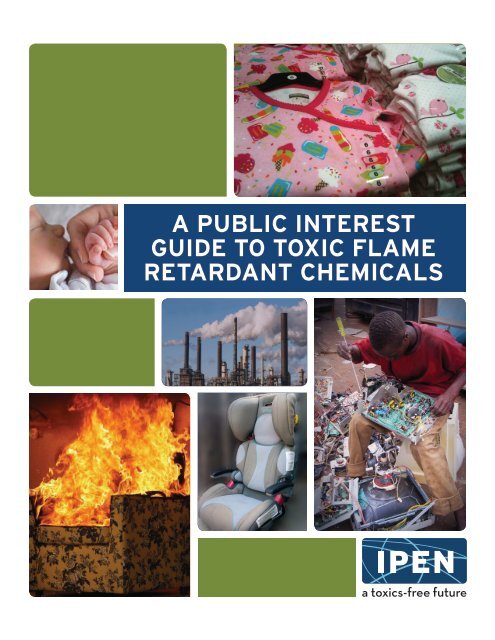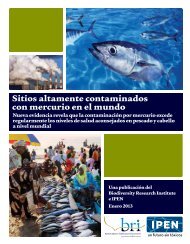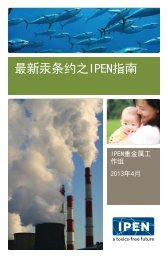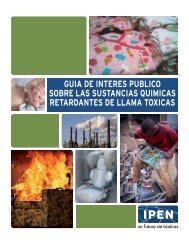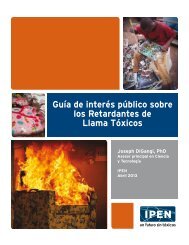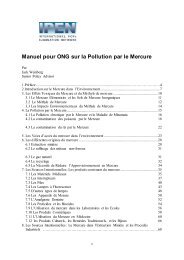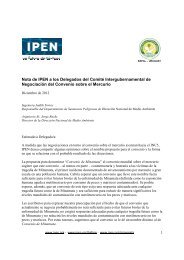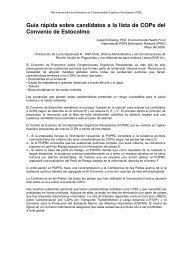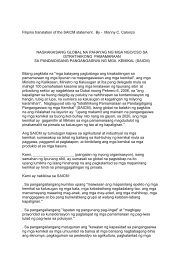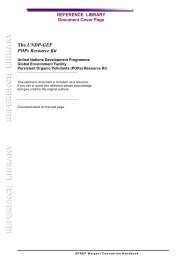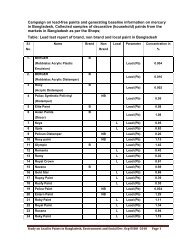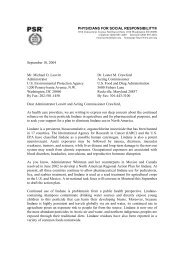A Public Interest Guide to Toxic Flame Retardant Chemicals
A Public Interest Guide to Toxic Flame Retardant Chemicals
A Public Interest Guide to Toxic Flame Retardant Chemicals
Create successful ePaper yourself
Turn your PDF publications into a flip-book with our unique Google optimized e-Paper software.
A PUBLIC INTEREST<br />
GUIDE TO TOXIC FLAME<br />
RETARDANT CHEMICALS
“WE DID NOT FIND FLAME RETARDANTS IN FOAM TO PROVIDE ANY SIGNIFI-<br />
CANT PROTECTION,” SAID DALE RAY, A TOP OFFICIAL WITH THE CONSUMER<br />
PRODUCT SAFETY COMMISSION…” — CHICAGO TRIBUNE, MAY 6, 2012<br />
2<br />
Image courtesy of U.S. Consumer Product Safety Commission
A PUBLIC INTEREST GUIDE TO TOXIC<br />
FLAME RETARDANT CHEMICALS<br />
Joseph DiGangi, PhD<br />
Senior Science and Technical Advisor<br />
IPEN<br />
ipen@ipen.org<br />
www.ipen.org<br />
CONTENTS<br />
1. INTRODUCTION .......................................................4<br />
2. INFORMATION SOURCES ...............................................4<br />
3. FIRE SAFETY .........................................................5<br />
4. SUBSTANCES MARKETED AS FLAME RETARDANTS ....................... 7<br />
5. INDUSTRY ACTIONS: A HISTORY OF DECEPTION ......................... 12<br />
6. ADDRESSING WASTES CONTAINING FLAME RETARDANT CHEMICALS ........15<br />
7. REGULATORY POLICY. . . . . . . . . . . . . . . . . . . . . . . . . . . . . . . . . . . . . . . . . . . . . . . . . 18<br />
8. PUBLIC INTEREST RECOMMENDATIONS AND ACTIONS ...................22<br />
9. CONCLUSION ........................................................24<br />
10. ABBREVIATIONS ....................................................26<br />
11. REFERENCES .......................................................26<br />
A PUBLIC INTEREST GUIDE TO TOXIC FLAME RETARDANT CHEMICALS<br />
3
1. INTRODUCTION<br />
<strong>Toxic</strong> chemicals marketed as flame retardants are widely present in our homes, our bodies,<br />
and even in our wastes. Due <strong>to</strong> increasing public health concerns, actions <strong>to</strong> regulate<br />
and eliminate them have occurred globally, nationally, and locally. However, the chemical<br />
industry continues <strong>to</strong> formulate new substances with similar <strong>to</strong>xic properties that are<br />
then incorporated in<strong>to</strong> many products. These substances are now found throughout the<br />
global environment, wildlife, and people, and even in areas far from where these substances<br />
are used or produced, like the Arctic.<br />
This public interest guide is a concise introduction <strong>to</strong> the science and politics of <strong>to</strong>xic<br />
flame retardants and includes a section on possible actions that can help reduce the<br />
harms of <strong>to</strong>xic chemicals <strong>to</strong> human health and the environment. It aims <strong>to</strong> raise public<br />
awareness about this harmful class of substances and stimulate action <strong>to</strong> reform how<br />
chemicals are produced, used, and substituted so that harms from <strong>to</strong>xic chemical exposure<br />
can ultimately be eliminated. While reading from start <strong>to</strong> finish provides a view<br />
of all the issues, readers are also encouraged <strong>to</strong> jump <strong>to</strong> the section of most interest <strong>to</strong><br />
them, the same way they would use a <strong>to</strong>ur guide.<br />
2. INFORMATION SOURCES<br />
This <strong>Guide</strong> primarily uses three key sources of information: 1) San An<strong>to</strong>nio Statement on<br />
Brominated and Chlorinated <strong>Flame</strong> <strong>Retardant</strong>s; 2) Chicago Tribune investigative series,<br />
“Playing with Fire”; and 3) Reports from UN processes such as the S<strong>to</strong>ckholm Convention<br />
on POPs and the Strategic Approach <strong>to</strong> International <strong>Chemicals</strong> Management. Links<br />
<strong>to</strong> these sources are provided in the References section.<br />
TOXIC CHEMICALS MARKETED AS<br />
FLAME RETARDANTS DO NOT PROVIDE<br />
FIRE SAFETY BENEFIT IN THE AMOUNTS<br />
ACTUALLY USED IN PRODUCTS<br />
In 2010, more than 200 scientists from 30 countries signed the San An<strong>to</strong>nio Statement<br />
in an effort <strong>to</strong> publicly raise concerns and call attention <strong>to</strong> neglected scientific information<br />
on bromine- and chlorine-containing flame retardants as a class. Environmental<br />
Health Perspectives published the fully-referenced Statement along with an edi<strong>to</strong>rial by<br />
Linda Birnbaum, Direc<strong>to</strong>r of the US National Institute of Environmental Health Sciences<br />
and the US National <strong>Toxic</strong>ology Program, and Ake Bergman, a prominent Swedish scientist<br />
and Direc<strong>to</strong>r of the Environmental Chemistry Unit in the Department of Materials<br />
and Environmental Chemistry at S<strong>to</strong>ckholm University. Birnbaum and Bergman de-<br />
4
scribed the Statement as, “… a call for attention <strong>to</strong> a continuing pattern of unfortunate<br />
substitution…” and “…a reasoned plea from the scientific community…”<br />
The Chicago Tribune published an in-depth four-part series on <strong>to</strong>xic chemicals marketed<br />
as flame retardants in May 2012. The four front-page articles described the widespread<br />
presence of the substances, and exposed how the chemicals do not actually provide fire<br />
safety benefit. The series exposed actions by the chemical industry <strong>to</strong> dis<strong>to</strong>rt science,<br />
invent phony industry advocacy groups, and even pay a prominent physician <strong>to</strong> invent<br />
testimony about non-existent patients <strong>to</strong> undermine legislative proposals <strong>to</strong> protect<br />
public health. The series shows how the <strong>to</strong>bacco industry used fire marshals <strong>to</strong> focus<br />
attention on production of flame retarding furniture with <strong>to</strong>xic chemicals instead of<br />
fire-safe cigarettes. Finally the series examines the weaknesses of a current fire safety<br />
standard and a chemical regula<strong>to</strong>ry system that allow these substances <strong>to</strong> be used in<br />
the first place. The series spurred senior Illinois Sena<strong>to</strong>r Richard Durbin <strong>to</strong> call for federal<br />
action by the US government on the matter, citing the startling facts reported in the<br />
series.<br />
<strong>Toxic</strong> chemicals marketed as flame retardants have attracted global attention and action<br />
through UN agreements. In 2009, more than 170 governments agreed on the global<br />
elimination of three flame retardants through the S<strong>to</strong>ckholm Convention. The widespread<br />
presence of flame retardant chemicals in electronic wastes led delegates participating<br />
in the Strategic Approach <strong>to</strong> International <strong>Chemicals</strong> Management <strong>to</strong> declare<br />
these types of hazardous chemicals <strong>to</strong> be a global emerging policy issue. At the same<br />
meeting, similar concerns about the lack of information on flame retardants and other<br />
types of <strong>to</strong>xic chemicals in consumer products led delegates from more than 100 countries<br />
<strong>to</strong> launch an ongoing project <strong>to</strong> tackle this problem by the United Nations Environment<br />
Programme (UNEP).<br />
3. FIRE SAFETY<br />
3.1 TOXIC CHEMICALS MARKETED AS FLAME RETARDANTS DO NOT<br />
ACTUALLY WORK IN PRODUCTS<br />
The chemical industry claims that adding <strong>to</strong>xic chemicals marketed as flame retardants<br />
<strong>to</strong> polyurethane foam (known in some countries as “foam rubber”) makes the difference<br />
“…between life and death.” However, in an interview with the Chicago Tribune, Dale Ray,<br />
a <strong>to</strong>p official with the US Consumer Product Safety Commission said, “We did not find<br />
flame retardants in foam <strong>to</strong> provide any significant protection.” Ray also said that the<br />
amount of smoke is similar in flame-retarded products and that most fire victims die of<br />
smoke inhalation, not flames. The federal agency now believes that the best way <strong>to</strong> fireproof<br />
furniture is <strong>to</strong> require upholstery <strong>to</strong> resist smoldering sources of ignition such as<br />
cigarettes. The agency notes that, “Most of the furniture sold <strong>to</strong>day already is covered<br />
with fabrics that comply with the proposed smolder standard…If furniture fabric s<strong>to</strong>ps<br />
a fire from starting in the first place…there is no reason <strong>to</strong> keep adding flame retardant<br />
chemicals <strong>to</strong> the foam underneath.” Underwriters Labora<strong>to</strong>ries also found that placing<br />
A PUBLIC INTEREST GUIDE TO TOXIC FLAME RETARDANT CHEMICALS<br />
5
a fire-resistant layer that does not contain<br />
<strong>to</strong>xic flame retardant chemicals between<br />
foam and fabric was much more effective<br />
than adding <strong>to</strong>xic flame retardant chemicals<br />
<strong>to</strong> the foam.<br />
3.2 NO FIRE SAFETY BENEFIT IN<br />
FURNITURE<br />
The chemical industry claims that adding<br />
<strong>to</strong>xic flame retardant chemicals <strong>to</strong> foam<br />
used in furniture gives people more time<br />
<strong>to</strong> escape a fire. A burn study cited by<br />
the industry showed that only very large<br />
amounts of chemicals slowed a fire. Yet,<br />
the chemical industry used the study <strong>to</strong><br />
claim that addition of <strong>to</strong>xic flame retardant<br />
chemicals <strong>to</strong> consumer products gives a<br />
15-fold increase in escape time in case of<br />
a fire. The Chicago Tribune interviewed<br />
the study’s author, Vy<strong>to</strong> Babrauskas, who<br />
called such claims, “… ‘<strong>to</strong>tally bogus’<br />
because the amounts of flame retardants<br />
in the burned samples in his tests were so<br />
much greater than what is found in typical<br />
consumer items.” Babrauskas noted<br />
that since furniture is covered with fabric,<br />
the flames from the burning fabric quickly<br />
overwhelm the foam, even if <strong>to</strong>xic chemicals<br />
are added. He added that household<br />
furniture often contains enough chemicals<br />
<strong>to</strong> pose health threats but not enough <strong>to</strong><br />
stem fires — “…the worst of both possible<br />
worlds.” Babrauskas called the chemical<br />
industry claims “flat-out deceptive” and<br />
said that they should s<strong>to</strong>p misrepresenting<br />
his work in order <strong>to</strong> sell more flame retardants.<br />
3.3 NO FIRE SAFETY BENEFIT IN<br />
ELECTRONICS<br />
The chemical industry claims that adding<br />
<strong>to</strong>xic flame retardant chemicals <strong>to</strong> plastics<br />
used in electronics provides a large<br />
fire safety benefit. However, the Chicago<br />
Tribune investigation found that this claim<br />
is based on unscientific methods. In 1997<br />
as questions were being raised in Europe<br />
about flame retardants in electronics, the<br />
chemical industry, “…began searching for<br />
evidence that the benefits of flame retardants<br />
in those products outweighed any<br />
risks.” The Tribune describes how three<br />
industry researchers unscientifically used<br />
a finding of only eight TV fires in Sweden<br />
<strong>to</strong> extrapolate <strong>to</strong> all of Europe and claim<br />
that it experienced 165 TV fires per million<br />
sets each year. Even more surprising (and<br />
completely unscientific) was the industry<br />
claim that since the US rate was five TV<br />
fires per million sets, the difference in “fire<br />
rates” must be due <strong>to</strong> the inclusion <strong>to</strong>xic<br />
flame retardant chemicals in US products.<br />
The Chicago Tribune interviewed the author<br />
of the Swedish study, Ingvar Enqvist.<br />
He <strong>to</strong>ld the paper, “…that he did not know<br />
Simonson and the chemical industry were<br />
relying on the eight TV fires mentioned in<br />
his report as the basis for sweeping claims<br />
about the benefits of flame retardants, a<br />
fact he called ‘a little peculiar.’ He also said<br />
Simonson shouldn’t extrapolate the eight<br />
fires <strong>to</strong> all of Europe, given the vast differences<br />
among the countries.”<br />
3.4 TOXIC FLAME RETARDANT<br />
CHEMICALS INCREASE DANGER OF<br />
DEATH IN FIRES<br />
According <strong>to</strong> the San An<strong>to</strong>nio Statement,<br />
brominated and chlorinated flame retar-<br />
6
dants can increase the release of carbon monoxide, <strong>to</strong>xic gases, and soot, which are<br />
the cause of most fire deaths and injuries. For example, the Statement cites a study<br />
that demonstrated PentaBDE-treated foam released approximately twice the amount of<br />
smoke, seven times the amount of carbon monoxide, and nearly 70 times the amount<br />
of soot, and only provided three additional seconds before ignition compared <strong>to</strong> foam<br />
that was not treated with the chemical. In many applications flame retardancy is simply<br />
not needed (for example breast feeding pillows) or the product can be designed in such<br />
a way that it achieves fire safety standards without the use of <strong>to</strong>xic flame retardant<br />
chemicals.<br />
3.5 DIOXIN AND FURAN FORMATION<br />
The San An<strong>to</strong>nio Statement notes that when brominated and chlorinated flame retardants<br />
burn, high yields of extremely <strong>to</strong>xic brominated-, chlorinated-, and bromo-chlorinated<br />
dioxins and furans are formed. This indicates that combusting waste containing<br />
certain consumer products can lead <strong>to</strong> the generation of highly <strong>to</strong>xic substances that<br />
have been found in human milk, food, and dust. The S<strong>to</strong>ckholm Convention lists chlorinated<br />
dioxins and furans as unintentionally formed substances, “…with the goal of their<br />
continuing minimization and, where feasible, ultimate elimination.” The Convention lists<br />
industrial source categories that have a high potential for formation and release of dioxins<br />
and furans including waste incinera<strong>to</strong>rs, cement kilns firing hazardous waste, various<br />
thermal processes in the metallurgical industry, open burning of waste, utility and industrial<br />
boilers, chemical processes involving chlorine, and shredder plants for treatment of<br />
end of life vehicles. At the Fifth Conference of the Parties, governments decided <strong>to</strong> encourage<br />
parties and stakeholders <strong>to</strong> implement the recommendations on burning wastes<br />
containing PBDE flame retardants provided by the expert committee known as the POPs<br />
Review Committee. In 2010, the Committee recommended, “To generate and collect<br />
information on releases of brominated diphenyl ethers and unintentionally produced brominated<br />
organic compounds such as polybrominated dibenzodioxins and polybrominated<br />
dibenzofurans (PBDD/PBDF) in emissions <strong>to</strong> air and in the solid residues from thermal<br />
processes used in treating materials contaminated with brominated diphenyl ethers.”<br />
4. SUBSTANCES MARKETED AS FLAME<br />
RETARDANTS<br />
4.1 LARGE AMOUNTS OF TOXIC CHEMICALS MARKETED AS FLAME<br />
RETARDANTS CAN BE PRESENT IN CONSUMER PRODUCTS IN HOMES<br />
The Chicago Tribune reported that a large couch can contain up <strong>to</strong> one kilogram or two<br />
pounds of <strong>to</strong>xic chemicals marketed as flame retardants in its cushions. This provides a<br />
large potential source of exposure <strong>to</strong> <strong>to</strong>xic substances since the chemicals emerge over<br />
time <strong>to</strong> contaminate dust. Due <strong>to</strong> the persistence of the chemicals and lifetime of couches<br />
and other products, <strong>to</strong>xic flame retardant chemicals can continue <strong>to</strong> contaminate<br />
homes and people long after they are prohibited. For example, recent studies show high<br />
A PUBLIC INTEREST GUIDE TO TOXIC FLAME RETARDANT CHEMICALS<br />
7
PentaBDE levels in California (US) residents even though the substance was prohibited<br />
in the state in 2008.<br />
4.2 MANY DIFFERENT TYPES OF CONSUMER PRODUCTS CONTAIN TOXIC<br />
CHEMICALS MARKETED AS FLAME RETARDANTS<br />
The Chicago Tribune reported on a scientific study that found <strong>to</strong>xic chemical flame<br />
retardants in highchairs, diaper-changing pads, and breast-feeding pillows. In 2011, an<br />
IPEN study found the chemicals in carpet padding. The San An<strong>to</strong>nio Statement notes<br />
that products containing <strong>to</strong>xic flame retardant chemicals include foam used in furniture,<br />
plastics used in electrical and electronic products, building materials such as insulation,<br />
and textiles.<br />
4.3 FIREMASTER 550 HAS TOXIC EFFECTS AND IS USED IN FURNITURE<br />
Firemaster 550 is a new, alternative substance introduced by the industry for use in furniture<br />
foam after the previous substance, PentaBDE, was prohibited globally under the<br />
S<strong>to</strong>ckholm Convention. The Chicago Tribune obtained health studies on the substance<br />
from Chemtura, the manufacturer. “They found that exposing rats <strong>to</strong> high doses of<br />
Firemaster 550 can lower birth weight, alter female genitalia and cause skeletal malformations<br />
such as fused ribs and vertebrae.” Chemtura claims the chemical is part of its<br />
“Greener Innovation” program. The Chicago Tribune reported that the EPA approved the<br />
substance knowing that it contained two brominated compounds (TBB and TBPH) that<br />
are similar <strong>to</strong> DEHP, a phthalate substance that the State of California lists as a known<br />
carcinogen and developmental <strong>to</strong>xicant. The newspaper also reported that US EPA<br />
scientists have known since the 1990s that burning products containing Firemaster 550<br />
could release dioxins.<br />
4.4 CHLORINATED TRIS IS TOXIC AND PRESENT IN CHILDREN’S PRODUCTS<br />
In the 1970s in the US, manufacturers voluntarily removed chlorinated tris from children’s<br />
pajamas after the substance was linked <strong>to</strong> cancer. However, it was never banned.<br />
In 2011, a study of foam-containing baby products by researchers at Duke University<br />
found that chlorinated tris was the most common flame retardant in these products.<br />
The Chicago Tribune reported that WHO, US National Cancer Institute and the US National<br />
Research Council, “…have identified the flame retardant as a cancer risk.” The<br />
newspaper also noted that, “In 2006, researchers at the U.S. Consumer Product Safety<br />
Commission cautioned that adding chlorinated tris <strong>to</strong> furniture would expose children <strong>to</strong><br />
nearly twice the daily dose deemed acceptable by the federal agency. The cancer risk for<br />
children during the first two years of life would be seven times higher than what most<br />
physicians, scientists and regula<strong>to</strong>rs consider acceptable, according <strong>to</strong> the safety commission’s<br />
report.”<br />
4.5 THE CHEMICAL INDUSTRY DISTORTED THE HEALTH RISKS TO<br />
CHILDREN OF A COMMON TOXIC CHEMICAL MARKETED AS A FLAME<br />
RETARDANT: DECABDE<br />
DecaBDE is commonly used in electronics, where it is released in dust. The Chicago<br />
Tribune described how the industry dis<strong>to</strong>rted the risks <strong>to</strong> children of this substance. In<br />
2002, the chemical industry hired Exponent, a US consulting firm often hired by corpo-<br />
8
ations, <strong>to</strong> analyze how children might be<br />
exposed <strong>to</strong> DecaBDE. The industry used a<br />
very small sample of adults <strong>to</strong> incorrectly<br />
make conclusions about health risks <strong>to</strong><br />
children and then even dis<strong>to</strong>rted the findings<br />
from this small sample. The industry<br />
used data from 1988 which measured<br />
DecaBDE in the blood of just 12 adults and<br />
found that five contained the chemical<br />
and seven did not. The Chicago Tribune<br />
reports that when Exponent reported the<br />
results for the industry they, “…flipped the<br />
findings around, emphasizing the seven<br />
samples where none of the chemical was<br />
detected.” They claimed that since “the<br />
majority” of serum samples (of adults) did<br />
not contain DecaBDE, that the majority of<br />
the entire population had low “if not zero”<br />
exposure. Exponent also claimed that no<br />
further evaluation of DecaBDE was warranted<br />
despite relying on only 12 samples<br />
from adults <strong>to</strong> make this conclusion about<br />
children. Dennis Paustenbach was the Vice<br />
President of Exponent at the time and he<br />
went on <strong>to</strong> write a publication based on<br />
this small number of samples from adults<br />
for the now defunct Journal of Children’s<br />
Health – a publication edited by Paustenbach.<br />
The journal folded a few months<br />
after publishing the “study”.<br />
4.6 OTHER CHEMICALS MARKETED<br />
AS FLAME RETARDANTS HAVE<br />
TOXIC CHARACTERISTICS THAT<br />
RAISE CONCERNS<br />
Overall, <strong>to</strong>xic chemicals marketed as flame<br />
retardants lack adequate <strong>to</strong>xicity information.<br />
However, the information that is available<br />
has raised concerns. For example, the<br />
San An<strong>to</strong>nio Statement notes a variety of<br />
harmful characteristics (see abbreviations<br />
list at the end of this document). HBCD<br />
used in insulation (Hexabromocyclododecane)<br />
is very <strong>to</strong>xic <strong>to</strong> aquatic organisms and<br />
can disrupt the hypothalamic-pituitarythyroid<br />
(HPT) axis, disrupting normal<br />
development, affecting the central nervous<br />
system, and inducing reproductive and<br />
developmental effects in mammals with<br />
some of them being trans-generational.<br />
Dechlorane Plus is used for coating electrical<br />
wires and cables, connec<strong>to</strong>rs used<br />
in computers, and plastic roofing material.<br />
Dechlorane Plus is poorly characterized<br />
<strong>to</strong>xicologically; however it resembles<br />
chlordane, dieldrin, endosulfan, endrin,<br />
and heptachlor – all substances listed<br />
in the S<strong>to</strong>ckholm Convention for global<br />
elimination. BTBPE is used in plastics and<br />
its metabolite, 2, 4, 6-tribomophenol, is a<br />
thyroid disrupting chemical found in umbilical<br />
cord blood. TBECH (1, 2-Dibromo-4-(1,<br />
2-dibromoethyl) cyclohexane) is used<br />
in home insulation, cables, plastics, and<br />
adhesives and is mutagenic <strong>to</strong> mammalian<br />
cells. PBEB (Pentabromoethylbenzene) is<br />
used in polymers and is poorly characterized<br />
<strong>to</strong>xicologically but the substance is a<br />
brominated analogue of ethyl benzene, a<br />
carcinogen. TBBPA (Tetrabromobisphenol<br />
A) is used in electronics, is structurally<br />
similar <strong>to</strong> thyroxin, shows thyroid hormone<br />
activity in vivo and in vitro, has estrogenic<br />
activity, and inhibits neurotransmitter uptake.<br />
TCEP (Tris (2-chloroethyl) phosphate)<br />
has been used in foam for furniture and<br />
A PUBLIC INTEREST GUIDE TO TOXIC FLAME RETARDANT CHEMICALS<br />
9
other products, causes adverse reproductive<br />
outcomes, and is considered a carcinogen<br />
under California Office of Environmental<br />
Health Hazard Assessment Proposition<br />
65.<br />
4.7 TOXIC CHEMICALS MARKETED<br />
AS FLAME RETARDANTS MIGRATE<br />
OUT OF PRODUCTS INTO HOMES<br />
AND THE ENVIRONMENT<br />
The San An<strong>to</strong>nio Statement notes that<br />
flame retardant chemicals are being found<br />
in all environmental matrices examined<br />
including air, water, soil sediment, and sewage<br />
sludge. Firemaster 550, a substitute<br />
chemical for PentaBDE in foam, has been<br />
found in house dust and in Arctic polar<br />
bears. Chemtura, the manufacturer, used<br />
a flawed method <strong>to</strong> “prove” the chemical<br />
would not migrate from products. As<br />
the Chicago Tribune reported, the method<br />
involved placing saline-soaked filter papers<br />
on a cot<strong>to</strong>n covered block of foam and<br />
measuring how much leaked out in only<br />
eight days. The newspaper interviewed<br />
Duke University researcher Heather Staple<strong>to</strong>n<br />
who found Firemaster 550 in house<br />
dust. “It’s ridiculous that they would keep<br />
saying this isn’t migrating from couches<br />
and other products,” Staple<strong>to</strong>n said. “We<br />
know this chemical is out there, and we<br />
know kids are chronically exposed <strong>to</strong> it.”<br />
The San An<strong>to</strong>nio Statement reports that<br />
chemical components of Firemaster 550<br />
are also found in the Arctic.<br />
4.8 TOXIC FLAME RETARDANT<br />
CHEMICALS ARE PRESENT IN<br />
DEVELOPING COUNTRIES<br />
Use of flame retardant chemicals has his<strong>to</strong>rically<br />
been concentrated in developed<br />
countries and studies show corresponding<br />
contamination of humans and the environment.<br />
However, moni<strong>to</strong>ring data in developing<br />
and transition countries is lacking so<br />
the scope of the problem is not well unders<strong>to</strong>od.<br />
The S<strong>to</strong>ckholm Convention POPs<br />
Review Committee found that while s<strong>to</strong>cks<br />
of wastes were likely <strong>to</strong> be low in developing<br />
countries, hotspots relating <strong>to</strong> ewaste<br />
sites were a potential problem. However,<br />
given the lack of data, in 2011 the Committee<br />
recommended surveys on flame<br />
retardant chemical levels in developing<br />
and transition countries, in part <strong>to</strong> address<br />
the possibility that transfer of other types<br />
of consumer products <strong>to</strong> developing and<br />
transition countries could be occurring. In<br />
2005, IPEN conducted a study of contaminants<br />
in home-grown chicken eggs near<br />
various types of hotspot sites in developing<br />
countries. <strong>Flame</strong> retardant chemicals<br />
such as PBDEs and HBCD were found in<br />
chicken eggs in Kenya (near a dumpsite),<br />
Mexico (near a petrochemical complex),<br />
Mozambique (near a cement kiln burning<br />
10
waste), Philippines (near a medical waste incinera<strong>to</strong>r), Turkey (near a hazardous waste<br />
incinera<strong>to</strong>r), and Uruguay (near a cement kiln burning waste). A recent study in China<br />
measured halogenated flame retardants in home-produced chicken eggs near three<br />
ewaste recycling sites. Researchers found very high levels of PBDEs, HBCD, polybrominated<br />
biphenyl (also known as hexabromobiphenyl), and other flame retardant chemicals<br />
in eggs.<br />
4.9 MANY BROMINATED AND CHLORINATED CHEMICALS MARKETED AS<br />
FLAME RETARDANTS ARE PERSISTENT AND BIOACCUMULATIVE<br />
<strong>Flame</strong> retardants contaminate the food chain, including human milk. The San An<strong>to</strong>nio<br />
Statement describes moni<strong>to</strong>ring studies that show that many <strong>to</strong>xic chemicals marketed<br />
as flame retardants are present in wildlife (including food sources) and humans. These<br />
include Firemaster 550 compounds, chlorinated tris, DBDPE, TBECH, HBCD, DBHCTCTD,<br />
PBEB, SCCPs, TBBPA, and HBB.<br />
4.10 CALIFORNIA (US) RESIDENTS – EVEN CHILDREN – CONTAIN THE<br />
WORLD’S HIGHEST HIGH LEVELS OF TOXIC FLAME RETARDANTS IN THEIR<br />
BODIES<br />
Two recent scientific studies published in 2011 indicate that California residents contain<br />
the world’s highest levels of <strong>to</strong>xic flame retardants in their bodies. The first study by researchers<br />
at the University of California – San Francisco, California Department of <strong>Toxic</strong><br />
Substances Control, and University of Massachusetts – Amherst measured the PBDE<br />
flame retardants in pregnant women. As Ami Zota, the lead author noted, “I summarized<br />
all the studies of pregnant women <strong>to</strong> date of PBDEs. There’s about 20. They included<br />
China, Japan, Sweden, Spain, Korea and various parts of the U.S. The levels in pregnant<br />
California women were 10 <strong>to</strong> 100 times higher than pregnant women in Europe and Asia,<br />
about two <strong>to</strong> three times higher than pregnant women in other parts of the U.S.” The<br />
second study was conducted by researchers at University of California – Berkeley, Centers<br />
for Disease Control and Prevention, and National Institute of <strong>Public</strong> Health in Cuernavaca,<br />
Mexico. The study found that Mexican-American children in California had seven<br />
times more flame retardants in their bodies than children in Mexico and three times<br />
more flame retardants in their bodies than their mothers. The study notes, “The few<br />
studies of PBDEs in children’s blood worldwide indicate that children living in California<br />
have some of the highest documented PBDE serum concentrations.”<br />
4.11 TOXIC CHEMICALS MARKETED AS FLAME RETARDANTS CAN TRAVEL<br />
LONG DISTANCES<br />
The San An<strong>to</strong>nio Statement describes studies that show the following substances used<br />
in consumer products are present in the Arctic or Antarctic: components of Firemaster<br />
550, Dechlorane Plus, BTBPE, DBDPE, PBEB, HBCD, TBBPA, TCEP, and HBB. In addition<br />
the Statement notes that the following substances used as flame retardants were identified<br />
in modeling studies as likely <strong>to</strong> be Arctic contaminants: tetra- <strong>to</strong> octabromodiphenyl<br />
ether, DecaBDE, HBCD, tetrabromocyclohexane, chlorendic acid, tetrabromophthalic<br />
anhydride, and 2,4,6-tribromophenol.<br />
A PUBLIC INTEREST GUIDE TO TOXIC FLAME RETARDANT CHEMICALS<br />
11
5. INDUSTRY ACTIONS: A HISTORY OF<br />
DECEPTION<br />
5.1 TOXIC CHEMICALS MARKETED AS FLAME RETARDANTS ARE MADE IN<br />
US, EUROPE, AND ASIA AND EXPORTED GLOBALLY<br />
Three main manufacturing companies are Albemarle (US), Chemtura (US), and ICL<br />
(Israel). In addition, Tosoh Corporation (Japan) also manufactures fire retardant chemicals.<br />
Manufacturing sites for these companies include Europe where substances such<br />
as HBCD are produced. There also appear <strong>to</strong> be a number of Chinese manufacturers<br />
including Shandong Tianyi Chemical, Shandong Weifang Yukai Chemical, Nanjing Mellon<br />
Chemical, Orising Chemical, Weifang Haihua Yuanda Fine Chemical, Star <strong>Chemicals</strong> and<br />
Catalysts, Nanjing Rising Chemical, Qingdao Haida Chemical, Shandong Ocean Chemical,<br />
CN Sinosou of Welcom, Weifang Yukai Chemical, Jinan Chenxu Chemical, Weifang<br />
Heqde Chemical, Weidong International Group, Shanghai Ruiyuan Chemical, and Weifang<br />
Dacheng Yili Pharmaceutical Co. Dow Chemical has developed a new brominated flame<br />
retardant substitute for HBCD known as Emerald 3000 and made it available for licensing<br />
by the manufacturers above.<br />
5.2 THE INDUSTRY HAS A HISTORY OF SUBSTITUTING ONE BAD CHEMICAL<br />
AFTER ANOTHER<br />
In an edi<strong>to</strong>rial published in Environmental Health Perspectives, Linda Birnbaum and<br />
Ake Bergman describe a his<strong>to</strong>ry of substitution by the industry from the 1970s <strong>to</strong> present<br />
day. The his<strong>to</strong>ry begins with hexabromobiphenyl contamination of cattle feed (now<br />
“...TOBACCO EXECUTIVES DIDN’T CARE<br />
FOR ONE OBVIOUS SOLUTION: CREATE A<br />
‘FIRE-SAFE’ CIGARETTE, ONE LESS LIKELY<br />
TO START A BLAZE...”<br />
banned globally) and tris (2, 3-dibromopropyl) phosphate in children’s pajamas (mutagen<br />
and banned). The industry next placed polybrominated diphenyl ethers (PBDEs)<br />
in<strong>to</strong> millions of products even though PBDEs are very similar in structure and effect <strong>to</strong><br />
PCBs, substances being eliminated globally through the S<strong>to</strong>ckholm Convention. HBCD,<br />
a slightly modified DecaBDE, TBBPA, Firemaster 550, and a whole host of new chemicals<br />
followed. The authors note that, “The San An<strong>to</strong>nio Statement is a call for attention<br />
<strong>to</strong> a continuing pattern of unfortunate substitution…even though there have been early<br />
warnings and periodic reminders about the problematic properties of these chemicals…<br />
Why do we not learn from the past?” In contrast <strong>to</strong> the industry practice, the S<strong>to</strong>ckholm<br />
Convention POPs Review Committee, an expert committee of the Convention, concluded<br />
in its alternative guidance document that alternatives should not have hazardous prop-<br />
12
erties, such as mutagenicity and carcinogenicity, or adverse effects on the reproductive,<br />
developmental, endocrine, immune, or nervous systems.<br />
5.3 THE TOBACCO INDUSTRY SHIFTED ATTENTION AWAY FROM<br />
CIGARETTES TO FLAME RETARDANT FURNITURE AS THE SOLUTION TO<br />
HOUSE FIRES INSTEAD OF FIRE-SAFE CIGARETTES<br />
In a time of rising numbers of house fires due <strong>to</strong> cigarette smoking, the <strong>to</strong>bacco industry<br />
sought <strong>to</strong> focus blame and a solution away from the actual cause of the fires. As the<br />
Chicago Tribune notes, “…<strong>to</strong>bacco executives didn’t care for one obvious solution: create<br />
a ‘fire-safe’ cigarette, one less likely <strong>to</strong> start a blaze…The industry insisted it could not<br />
make a fire-safe cigarette that would still appeal <strong>to</strong> smokers and instead promoted flame<br />
retardant furniture — shifting attention <strong>to</strong> the couches and chairs that were going up in<br />
flames. But executives realized they lacked credibility, especially when burn victims and<br />
firefighters were pushing for changes <strong>to</strong> cigarettes. So Big Tobacco launched an aggressive<br />
and cunning campaign <strong>to</strong> ‘neutralize’ firefighting organizations and persuade these<br />
far more trusted groups <strong>to</strong> adopt <strong>to</strong>bacco’s cause as their own.” Peter Sparber, a former<br />
<strong>to</strong>bacco industry executive served as the organizer of the US National Association of<br />
State Fire Marshals and the Tribune notes that, “He shaped its requests for federal rules<br />
requiring flame retardant furniture and fed the marshals <strong>to</strong>bacco’s arguments for why<br />
altering furniture was a more effective way <strong>to</strong> prevent fires than altering cigarettes…<br />
The fire marshals’ actions helped Big Tobacco fend off fire-safe requirements for years.”<br />
5.4 THE CHEMICAL INDUSTRY PAID FIRE MARSHALS TO LOBBY ASIAN<br />
ELECTRONICS MANUFACTURERS TO ADD CHEMICALS MARKETED AS<br />
FLAME RETARDANTS TO THEIR PRODUCTS<br />
The Chicago Tribune reports that the chemical industry paid for fire marshals’ lobbying<br />
trips <strong>to</strong> Japan, Korea, and Taiwan <strong>to</strong> convince manufacturers <strong>to</strong> add chemicals <strong>to</strong> plastic<br />
components of computer moni<strong>to</strong>rs and TVs.<br />
5.5 THE CHEMICAL INDUSTRY PAID FIRE MARSHALS TO LOBBY FOR<br />
GLOBAL FIRE STANDARDS ENCOURAGING USE OF CHEMICALS MARKETED<br />
AS FLAME RETARDANTS<br />
As the Chicago Tribune notes, “The marshals later pushed for worldwide standards<br />
requiring that the plastic casings of electronics resist a candle flame and posted Internet<br />
videos comparing name-brand computer moni<strong>to</strong>rs that went up in flames with those<br />
that didn’t.” The industry waged this campaign within the International Electrotechnical<br />
Commission (IEC). IEC is a standards setting body based in Switzerland with a technical<br />
committee (TC108) that focuses on safety standards including fire, electrical, and labeling.<br />
The chemical industry pressured the IEC <strong>to</strong> adopt a candle flame ignition standard in<br />
electronics which would require addition of their chemicals in plastics parts of electronic<br />
equipment. Opponents of the proposal included the US Consumer Product Safety Commission,<br />
US National Fire Protection Association, Consumer Electronics Association, and<br />
the Telecommunications Industry Association. They cited information that concluded<br />
that candle flames were not appropriate or realistic as a standard and that no fire safety<br />
benefit would result from using this standard. Despite strong opposition, the chemical<br />
A PUBLIC INTEREST GUIDE TO TOXIC FLAME RETARDANT CHEMICALS<br />
13
industry proceeded <strong>to</strong> propose and pressure for passage of the standard. In 2008, international<br />
civil society networks raised awareness among TC108 members about the lack<br />
of fire safety benefit, and the measure was defeated. In May 2012, a similar measure was<br />
defeated again. If the proposal had succeeded, then millions of kilograms of <strong>to</strong>xic flame<br />
retardant chemicals would have been dispersed globally in electronic products.<br />
5.6 A LEADING US MEDICAL DOCTOR FABRICATED PATIENTS AND CAUSE<br />
OF DEATH IN TESTIMONY TO LEGISLATORS<br />
Dr. David Heimbach, a prominent retired burn specialist, fabricated testimony on numerous<br />
occasions about children dying due <strong>to</strong> fires started by a candle on products lacking<br />
flame retardants. As noted by the Chicago Tribune, “…records and interviews show that<br />
the baby Heimbach said he had in mind when testifying didn’t die as he described and<br />
that flame retardants were not a fac<strong>to</strong>r.” The paper notes that, “The baby he described<br />
didn’t exist. Neither did the 9-week-old patient who Heimbach <strong>to</strong>ld California legisla<strong>to</strong>rs<br />
died in a candle fire in 2009. Nor did the 6-week-old patient who he <strong>to</strong>ld Alaska lawmakers<br />
was fatally burned in her crib in 2010. Heimbach is not just a prominent burn doc<strong>to</strong>r.<br />
He is a star witness for the manufacturers of flame retardants.” Under questioning by<br />
the Chicago Tribune, Heimbach admitted that the chemical industry paid for his travel<br />
and “some of his time”.<br />
5.7 CHEMICAL INDUSTRY HAS EXPLOITED RACE TO ARGUE FOR ADDITION<br />
OF TOXIC CHEMICALS IN CONSUMER PRODUCTS<br />
As the Chicago Tribune notes, the chemical industry, through their front group, Citizens<br />
for Fire Safety, have used a “…powerful and surprising tactic: making flame retardants<br />
a racial issue. The group and witnesses with ties <strong>to</strong> it have argued that impoverished,<br />
minority children would burn <strong>to</strong> death if flame retardants were removed from household<br />
products.” The assertion was not true, and the group did not disclose their connection<br />
<strong>to</strong> the industry association during their legislative testimony. Ironically, on 23 May 2012,<br />
the Chicago Tribune reported on a new US scientific study showing that African American<br />
and Latino <strong>to</strong>ddlers had twice the levels of PBDE flame retardants in their bodies<br />
as white children. The paper noted that the study “…challenges one of industry’s chief<br />
arguments for expanding use of the chemicals.”<br />
5.8 THE TOBACCO INDUSTRY ATTEMPTED TO GET FURNITURE WITHOUT<br />
TOXIC CHEMICALS LABELED AS HAZARDOUS MATERIAL<br />
Peter Sparber, a US <strong>to</strong>bacco industry executive, worked as a lobbyist for Chemtura. As<br />
the Chicago Tribune reports, Sparber helped get the fire marshals <strong>to</strong> ask federal regula<strong>to</strong>rs<br />
<strong>to</strong> require warning labels made with non-fire-retardant foam saying they were<br />
hazardous material. The Tribune notes that Sparber also tried, “…<strong>to</strong> get furniture s<strong>to</strong>res<br />
declared ‘hazardous occupancies,’ a classification usually reserved for locations handling<br />
gasoline…” The rules were not adopted, but the Tribune notes that the furniture<br />
industry was intimidated in<strong>to</strong> including the chemicals in<strong>to</strong> its products.<br />
14
5.9 CITIZENS FOR FIRE SAFETY IS A TRADE ASSOCIATION FOR CHEMICAL<br />
COMPANIES<br />
Despite the “grassroots” appearance on their website, Citizens for Fire Safety has as its<br />
three members the chemical companies Albemarle, ICL Industrial Products, and Chemtura;<br />
these are the main flame retardant manufacturers. Tax records show the mission of<br />
the association is <strong>to</strong> “…promote common business interests of members involved with<br />
the chemical manufacturing industry.” According <strong>to</strong> the Chicago Tribune, the association<br />
revenue is “…about $17 million between 2008 and 2010…” and “Many of the witnesses<br />
supporting flame retardants at these [legislative] hearings were either paid directly by<br />
Citizens for Fire Safety or were members of groups that benefited financially from Citizens<br />
for Fire Safety’s donations.”<br />
5.10 BROMINE SCIENCE AND ENVIRONMENTAL FORUM (BSEF) IS A TRADE<br />
ASSOCIATION FOR CHEMICAL COMPANIES<br />
Chicago Tribune notes that BSEF: “…may sound like a neutral scientific body. But it was<br />
founded and funded by four chemical manufacturers, including Albemarle, <strong>to</strong> influence<br />
the debate about flame retardants made with bromine.” Albemarle’s Raymond Dawson<br />
described BSEF as, “…a group dedicated <strong>to</strong> generating science in support of brominated<br />
flame retardants.”<br />
5.11 ALLIANCE FOR CONSUMER SAFETY IS A TRADE ASSOCIATION FOR<br />
CHEMICAL COMPANIES.<br />
The Chicago Tribune notes that the global PR firm, Burson Marstellar, helps run the Alliance<br />
for Consumer Safety, “…which is funded by a trade association of flame retardant<br />
manufacturers.”<br />
5.12 THE CHEMICAL INDUSTRY SPONSORS THE US FIRE MARSHALS<br />
Chemtura, one of the world’s largest manufacturers of <strong>to</strong>xic chemicals marketed as<br />
flame retardants, is a financial sponsor of the National Association of State Fire Marshals<br />
and their logo appears on the group’s website. Karen Deppa, who worked at the<br />
Tobacco Institute and later with Peter Sparber, is employed by the Fire Marshals in the<br />
area of external relations.<br />
6. ADDRESSING WASTES CONTAINING FLAME<br />
RETARDANT CHEMICALS<br />
6.1 WASTES CONTAINING FLAME RETARDANT CHEMICALS WITH<br />
PERSISTENT ORGANIC POLLUTANT (POP) CHARACTERISTICS SHOULD BE<br />
DISPOSED OF SAFELY<br />
Many <strong>to</strong>xic chemicals marketed as flame retardants have POPs (persistent organic<br />
pollutants –chemicals that bio-accumulate and persist in the environment) properties.<br />
When these products become wastes, these chemicals can further contaminate the en-<br />
A PUBLIC INTEREST GUIDE TO TOXIC FLAME RETARDANT CHEMICALS<br />
15
vironment and food chain. As noted above,<br />
highly <strong>to</strong>xic dioxins and furans are formed<br />
if these products are burned. According <strong>to</strong><br />
the S<strong>to</strong>ckholm Convention, the POPs content<br />
of wastes should be destroyed or irreversibly<br />
transformed so that they do not<br />
exhibit the characteristics of POPs. This<br />
prevents further release of substances<br />
in<strong>to</strong> the environment and food chain that<br />
will simply bioaccumulate again, causing<br />
further harm. This is a legal obligation of<br />
more than 170 countries for the substances<br />
listed in the S<strong>to</strong>ckholm Convention.<br />
6.2 FLAME RETARDANT CHEMICALS<br />
SHOULD BE REMOVED BEFORE<br />
PRODUCT RECYCLING<br />
Plastics and foam containing flame retardant<br />
chemicals are often recycled in<strong>to</strong><br />
other consumer products. This raises concerns<br />
about <strong>to</strong>xic chemicals moving from<br />
one product in<strong>to</strong> another and continuing<br />
human and environmental exposure. The<br />
S<strong>to</strong>ckholm Convention prohibits disposal<br />
operations that may lead <strong>to</strong> recovery,<br />
recycling, reclamation, direct reuse,<br />
or alternative uses of the substances.<br />
However in 2009, when flame retardant<br />
chemicals such as PentaBDE and OctaBDE<br />
were listed in the treaty, delegates agreed<br />
<strong>to</strong> make an exemption <strong>to</strong> allow the recycling<br />
of foams and plastics containing<br />
these substances. Due <strong>to</strong> concerns about<br />
the practice, they requested the expert<br />
committee, the POPs Review Committee<br />
(POPRC) <strong>to</strong> examine the practice. The<br />
POPRC recommended eliminating the<br />
flame retardant chemicals from recycling<br />
“…as swiftly as possible.” The POPRC said<br />
that simply recycling the products would<br />
disperse the chemicals in<strong>to</strong> other products<br />
and continue exposure. To highlight<br />
the issue, IPEN did a study <strong>to</strong> examine<br />
recycled foam carpet padding. PentaBDE,<br />
OctaBDE or both substances were found<br />
in 88% of samples from Canada, Hungary,<br />
and the US. Half the samples contained<br />
components of PentaBDE at levels that<br />
exceeded the indicative hazardous waste<br />
limit under European Union regulation.<br />
For OctaBDE components, 46% of the<br />
samples exceeded the limit. Products included<br />
items from Budapest, Hungary, the<br />
Canadian provinces of British Columbia,<br />
Mani<strong>to</strong>ba, and Ontario, and US states of<br />
Alaska, Michigan, New York, and Washing<strong>to</strong>n.<br />
PentaBDE and OctaBDE are released<br />
from foams and plastics in<strong>to</strong> house dust<br />
and pose significant hazards for infants<br />
and <strong>to</strong>ddlers. Children under four years old<br />
who crawl around on carpets already have<br />
the highest levels of PBDEs in the general<br />
population. People who recycle foam and<br />
lay carpet have been found <strong>to</strong> have 10<br />
times the amount of these chemicals in<br />
16
their body as the general public. The New York Times investigated the issue and found<br />
that according <strong>to</strong> the industry, 12.3 billion pounds (~6 billion kg) of recycled foam carpet<br />
padding is in homes and offices in the US alone.<br />
6.3 DUMPING OF NEAR-END-OF-LIFE AND END-OF-LIFE ELECTRICAL AND<br />
ELECTRONIC PRODUCTS RELEASES TOXIC FLAME RETARDANT CHEMICALS<br />
Near-end-of-life and end-of-life electrical and electronic products are a growing concern<br />
as a result of dumping in developing countries, which results in the illegal transboundary<br />
movement of <strong>to</strong>xic substances such as metals and <strong>to</strong>xic chemical flame retardants.<br />
More than 110 countries agreed that this represented a serious problem in a formal decision<br />
taken at the Second International Conference on <strong>Chemicals</strong> Management in 2009<br />
<strong>to</strong> develop recommendations for global action. Electronic waste is the fastest growing<br />
waste stream in the world with rates three times faster than municipal solid waste. Approximately<br />
20 – 50 million <strong>to</strong>nnes a year of electronic<br />
waste is generated and large amounts are dumped in<br />
Asia and Africa. The subsequent recycling operations<br />
cause large chemical exposures <strong>to</strong> workers including<br />
women and children as well as environmental contamination.<br />
6.4 LACK OF CAPACITY TO HANDLE<br />
ELECTRONIC WASTE<br />
There is a lack of capacity <strong>to</strong> handle electronic waste<br />
in an environmentally sound manner in almost all<br />
developing countries and countries with economies in<br />
transition. Many developed countries also struggle <strong>to</strong><br />
address this growing waste stream. This leads <strong>to</strong> the release of hazardous substances<br />
that cause harm <strong>to</strong> human health and the environment. More than 110 countries agreed<br />
that this represented a serious problem in a formal decision taken at the Second International<br />
Conference on <strong>Chemicals</strong> Management in 2009.<br />
6.5 WASTES CONTAINING FLAME RETARDANTS WITH POPS PROPERTIES<br />
SHOULD NOT BE TRANSPORTED ACROSS INTERNATIONAL BOUNDARIES<br />
UNLESS IT IS FOR PROPER DISPOSAL<br />
In 2009, a major debate erupted at the S<strong>to</strong>ckholm Convention 5 th Conference of the<br />
Parties over whether wastes containing flame retardants could be exported <strong>to</strong> developing<br />
and transition countries. The 53 countries of the African group, led by Kenya,<br />
pushed developed countries <strong>to</strong> ensure that wastes containing <strong>to</strong>xic flame retardants<br />
are not exported <strong>to</strong> Africa. Kenya proposed the ban after the treaty expert committee<br />
recommended ending the practice of recycling products containing flame retardants<br />
and s<strong>to</strong>pping their export. After a long debate, delegates agreed on text that encourages<br />
countries <strong>to</strong> ensure that waste materials containing PBDEs listed in the treaty are<br />
not exported <strong>to</strong> developing and transition countries. The decision cites the treaty text<br />
which notes that POPs can only be transported across international boundaries for the<br />
purpose of environmentally sound disposal in such a way that the POPs content is destroyed<br />
or irreversibly transformed.<br />
Image courtesy of BAN.org<br />
A PUBLIC INTEREST GUIDE TO TOXIC FLAME RETARDANT CHEMICALS<br />
17
7. REGULATORY POLICY<br />
7.1 THE CALIFORNIA STANDARD, TB117, HAS HAD A PROFOUND GLOBAL<br />
INFLUENCE<br />
The state of California established TB117 in 1975 in response <strong>to</strong> concerns about fires on<br />
furniture started by cigarettes. All products sold in California must meet the TB117 standard<br />
and California is the only US state that has such a law. Therefore, manufacturers<br />
usually opt for including flame retardant chemicals in all foam products <strong>to</strong> ensure access<br />
<strong>to</strong> the California market. Since many US companies export products and many countries<br />
are urged <strong>to</strong> follow US standards, the California TB117 standard has become the de<br />
fac<strong>to</strong> global standard for foam-containing products. Items bearing the TB117 label can be<br />
found in states and countries that are not required <strong>to</strong> abide by it. In this way, TB117 has<br />
helped contaminate products, humans, and the global environment. The TB117 standard<br />
is based on exposing raw foam <strong>to</strong> a candle flame for 12 seconds. <strong>Chemicals</strong> added <strong>to</strong> the<br />
foam help it pass the test. However in a house fire, the fabric covering the foam burns<br />
first and overwhelms the foam, even if it contains the chemicals. The standard does not<br />
reflect real life conditions in a fire. Instead, it merely paves the way for requiring <strong>to</strong>xic<br />
chemicals that do not actually provide a fire safety benefit.<br />
7.2 A BETTER FIRE SAFETY STANDARD REQUIRES FABRIC TO RESIST<br />
SMOLDERING SOURCES<br />
The US Consumer Product Safety Commission believes that the best way <strong>to</strong> fireproof<br />
furniture is <strong>to</strong> require upholstery <strong>to</strong> resist smoldering sources of ignition such as cigarettes.<br />
The agency notes that, “Most of the furniture sold <strong>to</strong>day already is covered with<br />
fabrics that comply with the proposed smolder standard… If furniture fabric s<strong>to</strong>ps a<br />
fire from starting in the first place, there is no reason <strong>to</strong> keep adding flame retardant<br />
chemicals <strong>to</strong> the foam underneath.” Underwriters Labora<strong>to</strong>ries also found that placing a<br />
fire-resistant layer between foam and fabric was much more effective than adding <strong>to</strong>xic<br />
chemicals marketed as flame retardants.<br />
7.3 THREE TOXIC FLAME RETARDANT CHEMICALS ARE BANNED GLOBALLY<br />
Parties <strong>to</strong> the S<strong>to</strong>ckholm Convention have taken action on three flame retardants that<br />
have been listed in the treaty for global elimination. The substances are commercial<br />
pentabromodiphenyl ether (PentaBDE) used in foam for furniture; commercial octabromodiphenyl<br />
ether (OctaBDE) used in plastics for electronics products; and hexabromobiphenyl<br />
used in plastics and au<strong>to</strong> upholstery. Velsicol manufactured hexabromobiphenyl<br />
in the 1970s. PentaBDE and OctaBDE were manufactured by Albemarle (US), Chemtura<br />
(US), ICL (Israel), and Tosoh (Japan).<br />
7.4 HBCD, THE THIRD MOST COMMONLY USED FLAME RETARDANT,<br />
REQUIRES GLOBAL ACTION<br />
The S<strong>to</strong>ckholm Convention is preparing <strong>to</strong> decide whether <strong>to</strong> add HBCD <strong>to</strong> its list for<br />
global elimination. In 2010, the S<strong>to</strong>ckholm Convention POPs Review Committee concluded<br />
that, HBCD is likely, as a result of its long-range environmental transport, <strong>to</strong> lead <strong>to</strong><br />
significant adverse human health and environmental effects, such that global action is<br />
18
warranted. This conclusion means that the<br />
treaty expert committee considers HBCD<br />
<strong>to</strong> be a persistent organic pollutant (POP)<br />
and one of the world’s worst chemicals.<br />
7.5 NORWAY PLANS TO ELIMINATE<br />
BROMINATED FLAME RETARDANTS<br />
BY 2020<br />
PentaBDE, OctaBDE, DecaBDE, and PBB<br />
are currently banned in Norway. The<br />
industry has voluntarily withdrawn HBCDcontaining<br />
insulation from the market<br />
in Norway and Sweden since alternative<br />
construction techniques with the chemicals<br />
provided a safer alternative. Waste<br />
that contains 0.25% or more PentaBDE,<br />
OctaBDE, DecaBDE, HBCD or TBBPA is<br />
defined as hazardous waste. New flame<br />
retardants are currently under investigation.<br />
Norway has established a priority list<br />
for phase-out of all emissions and uses for<br />
the purpose of eliminating them by 2020.<br />
The list includes flame retardant chemicals<br />
such as PentaBDE, OctaBDE, DecaBDE,<br />
HBCD, and TBBPA. Other substances on<br />
the list include bisphenol A, DEHP, SCCPs,<br />
PFOA, PFOS, perchloroethylene, trichloroethylene,<br />
and triclosan.<br />
7.6 THE EUROPEAN UNION (EU) HAS<br />
BANNED SOME FLAME RETARDANT<br />
CHEMICALS<br />
PentaBDE, OctaBDE and hexabromobiphenyl<br />
are banned in the EU. The European<br />
Chemical Agency identified TCEP as a<br />
Substance of Very High Concern with a<br />
sunset date of 2015. DecaBDE is prohibited<br />
in electronics, but permitted in other uses.<br />
Other flame retardants used in electronics<br />
such as TBBPA are permitted. Electronic<br />
waste containing these flame retardants<br />
often finds its way <strong>to</strong> dump sites in Africa<br />
and Asia, often in the form of near-end-oflife<br />
products that rapidly become wastes<br />
after entry in<strong>to</strong> the country.<br />
7.7 A WEAK CHEMICAL REGULATORY<br />
POLICY PERMITS NEW TOXIC FLAME<br />
RETARDANTS TO BE ADDED TO<br />
CONSUMER PRODUCTS<br />
The 1976 US regula<strong>to</strong>ry law on chemicals<br />
is weak, outdated, and does not protect<br />
human health. However it is often used as<br />
a model for policy in developing and transition<br />
countries. The EPA admitted <strong>to</strong> the<br />
Chicago Tribune that “…it is largely powerless<br />
<strong>to</strong> do anything about chlorinated tris<br />
[carcinogen in children’s products]. The<br />
agency cited industry’s continued use of<br />
the chemical as a stark example of why<br />
it supports’ much needed reform’ of the<br />
nation’s chemical safety law.” The Chicago<br />
Tribune noted that the 1970s <strong>Toxic</strong> Substances<br />
Control Act (TSCA), “…allows manufacturers<br />
<strong>to</strong> sell products without proving<br />
they are safe and <strong>to</strong> treat the formulas as<br />
trade secrets. Once health effects are documented,<br />
the law makes it almost impossible<br />
for the EPA <strong>to</strong> ban chemicals…To ban<br />
a chemical already on the market, the EPA<br />
must prove that it poses an ‘unreasonable<br />
risk’. Federal courts have established such<br />
a narrow definition of ‘unreasonable’ that<br />
A PUBLIC INTEREST GUIDE TO TOXIC FLAME RETARDANT CHEMICALS<br />
19
the [US] government couldn’t even ban asbes<strong>to</strong>s, a well-documented carcinogen that<br />
has killed thousands of people who suffered devastating lung diseases.” Due <strong>to</strong> these<br />
obstacles under TSCA, US EPA negotiated voluntary phase-outs of PentaBDE, OctaBDE,<br />
and DecaBDE with manufacturers. Electronic waste and other end of life products from<br />
the US containing these flame retardants often find their way <strong>to</strong> dump sites in Africa and<br />
Asia. Several US legisla<strong>to</strong>rs have introduced the Safe <strong>Chemicals</strong> Act <strong>to</strong> improve chemical<br />
safety and remedy the problems under the current law.<br />
7.8 US STATES HAVE ACTED TO BAN CERTAIN TOXIC CHEMICALS<br />
MARKETED AS FLAME RETARDANTS<br />
In the absence of federal regulation <strong>to</strong> assess or protect the public from dangers posed<br />
by <strong>to</strong>xic chemicals, US states have taken action. Twelve states have banned PentaBDE<br />
and OctaBDE including: California, Hawaii, Illinois, Maine, Maryland, Michigan, Minnesota,<br />
New York, Oregon, Rhode Island, Washing<strong>to</strong>n, and Vermont. Five states have banned DecaBDE<br />
including: Hawaii, Maine, Maryland, Oregon, and Vermont. The New York Senate<br />
Committee on Environmental Conservation voted unanimously in favor of a legislative<br />
proposal <strong>to</strong> prohibit companies from selling children’s products containing chlorinated<br />
tris as of December 2014.<br />
7.9 CERTAIN REQUIREMENTS SHOULD BE MET WHEN COMPANIES ASK FOR<br />
EXEMPTIONS TO PERMIT THE USE OF FLAME RETARDANT CHEMICALS IN<br />
PRODUCTS<br />
Often when use of a chemical is prohibited due <strong>to</strong> concerns about harms <strong>to</strong> human<br />
health and the environment, companies demand exemptions for as many uses as possible<br />
in order <strong>to</strong> preserve sales. These requests should be carefully examined <strong>to</strong> ensure<br />
that they are substantive and justified. In this process, governments would benefit from<br />
having some guidelines <strong>to</strong> justify requests for exemptions. The S<strong>to</strong>ckholm Convention<br />
POPs Review Committee addressed this issue in a guidelines document on alternatives.<br />
As described in the San An<strong>to</strong>nio Statement, when seeking exemptions for certain applications<br />
of <strong>to</strong>xic chemicals, the party requesting the exemption should supply information<br />
indicating why the exemption is technically or scientifically necessary and why<br />
potential alternatives are not technically or scientifically viable; a description of potential<br />
alternative processes, products, materials, or systems that eliminate the need for<br />
the chemical; and a list of sources researched.<br />
7.10 PRODUCT STEWARDSHIP AND EXTENDED PRODUCER RESPONSIBILITY<br />
SHOULD BE PART OF REGULAR PRACTICES FOR CONSUMER PRODUCTS<br />
More than 110 countries agreed on this aspect of corporate obligations in a formal decision<br />
taken at the Second International Conference on <strong>Chemicals</strong> Management in 2009.<br />
The focus of the decision was hazardous substances within the life cycle of electrical<br />
and electronic products. However, for flame retardant chemicals the issue extends <strong>to</strong><br />
furniture and a whole host of other consumer products that can find their way in<strong>to</strong> many<br />
countries as products and/or wastes. Developing and transition countries generally do<br />
not have the capacity <strong>to</strong> detect and separate these substances before disposal. In addition,<br />
developing and transition countries do not have proper hazardous waste disposal<br />
facilities for substances with POPs properties. Many products are simply mixed <strong>to</strong>gether<br />
20
and burned, creating and releasing dioxins, furans, and other <strong>to</strong>xic substances. Proper<br />
product stewardship and extended producer responsibility should include take back<br />
programs that relieve burdens on developing and transition country governments and<br />
prevent further emissions of <strong>to</strong>xic flame retardants and other byproducts during improper<br />
waste handling.<br />
7.11 ACCESS TO INFORMATION ON CHEMICALS IN PRODUCTS NEEDS TO BE<br />
IMPROVED<br />
More than 110 countries agreed on this aspect of chemical safety in a formal decision<br />
taken at the Second International Conference on <strong>Chemicals</strong> Management in 2009. Delegates<br />
agreed on the need for information on chemicals throughout their life cycle and<br />
that the information should be “…accessible, user-friendly, adequate and appropriate <strong>to</strong><br />
the needs of all stakeholders.” This is true for both developed and developing and transition<br />
countries. Information on chemicals in products should provide consumers with the<br />
information they are looking for, information which is transparent, available, accessible,<br />
clear, credible, up-<strong>to</strong>-date, comparable, appropriate <strong>to</strong> the needs of all stakeholders, and<br />
which considers substitution and alternatives. An information system on chemicals in<br />
products should help people make informed decisions about the products that they purchase,<br />
use or dispose of. For more than 170 countries that are Parties <strong>to</strong> the S<strong>to</strong>ckholm<br />
Convention, the treaty requires dissemination of information on relevant flame retardant<br />
chemicals and their health and environmental effects <strong>to</strong> policy and decision-makers,<br />
the wider public, and especially women, children, and the least educated as outlined in<br />
Article 10 of the S<strong>to</strong>ckholm Convention.<br />
7.12 CONSUMERS CAN PLAY A ROLE IN THE ADOPTION OF ALTERNATIVES<br />
IF PRODUCTS ARE LABELED<br />
If consumers are made aware of the presence of substances in products they can be<br />
empowered <strong>to</strong> make alternative choices. Labeling can play a key role in this process.<br />
This is the conclusion of the S<strong>to</strong>ckholm Convention POPs Review Committee, an expert<br />
committee of the Convention that approved a guidance document on considerations<br />
relating <strong>to</strong> alternatives and substitutes. Labels should be clear and understandable <strong>to</strong> all<br />
consumers and include safety information with the product.<br />
7.13 ALTERNATIVES TO TOXIC CHEMICALS DO NOT HAVE TO BE CHEMICALS<br />
Alternatives can include innovative changes in the design of products, industrial processes,<br />
and other practices that do not require the use of any flame retardant. This is<br />
the conclusion of the S<strong>to</strong>ckholm Convention POPs Review Committee, an expert committee<br />
of the Convention that approved a guidance document on considerations relating<br />
<strong>to</strong> alternatives and substitutes. For example, non-chemical alternatives in furniture can<br />
include synthetic fabrics or inherently flame retardant barriers that both resist smoldering<br />
sources of ignition. Electronics can be re-designed <strong>to</strong> separate high-voltage parts<br />
from outer casings or shielded with metal instead of plastic. Fire-resistive construction<br />
techniques can eliminate the need for flame retardant chemicals in insulation along with<br />
alternative materials such as natural fiber-based materials. The S<strong>to</strong>ckholm Convention<br />
alternatives guidance document states that alternative chemicals should not “...have<br />
hazardous properties that raise serious concern, such as mutagenicity, carcinogenicity<br />
A PUBLIC INTEREST GUIDE TO TOXIC FLAME RETARDANT CHEMICALS<br />
21
or adverse effects on the reproductive, developmental, endocrine, immune or nervous<br />
systems” and that “Non-chemical alternatives include alternative industrial processes<br />
and innovative practices.” To identify these alternatives, the S<strong>to</strong>ckholm Convention alternatives<br />
guidance suggests that, “End-users of products that contain listed persistent<br />
organic pollutants or candidate chemicals are essential sources of information on alternatives<br />
because they are in the best position <strong>to</strong> select alternatives that do not contain<br />
those chemicals. End-users constitute a broader category than industrial users and include<br />
farmers, hospitals, retailers, Governments and original equipment manufacturers.”<br />
8. PUBLIC INTEREST RECOMMENDATIONS<br />
AND ACTIONS<br />
A wide variety of public interest recommendations and actions can help reduce the<br />
harms of <strong>to</strong>xic chemicals <strong>to</strong> human health and the environment. Examples for <strong>to</strong>xic<br />
flame retardant chemicals include:<br />
• Wide dissemination of the Chicago Tribune series and the San An<strong>to</strong>nio Statement <strong>to</strong><br />
raise awareness among civil society groups, legisla<strong>to</strong>rs, health professionals and others<br />
across the globe<br />
• Strengthened chemical regula<strong>to</strong>ry policy based on the precautionary principle that<br />
provides information on chemicals as a condition for sale; implements a publicly<br />
available pollutant release and transfer registry; permits rapid removal of harmful<br />
chemicals from the market; provides incentives for safer non-chemical and chemical<br />
alternatives; and incorporates the polluter pays principle so that responsible parties<br />
pay the costs of chemical pollution<br />
• For S<strong>to</strong>ckholm Convention Parties, dissemination of information on relevant flame<br />
retardant chemicals and their health and environmental effects should be directed at<br />
policy and decision-makers, the wider public, and especially women, children, and the<br />
least educated as outlined in Article 10 of the S<strong>to</strong>ckholm Convention<br />
• Immediate elimination of <strong>to</strong>xic flame retardant chemicals in products that are not<br />
a fire risk and promote safe alternatives. For example, breast feeding pillows do not<br />
need <strong>to</strong> be flame retarded.<br />
• Implementation of a fire safety standard in furniture that requires upholstery <strong>to</strong><br />
resist smoldering sources of ignition such as cigarettes, not a standard based on<br />
ignition of foam<br />
• Elimination of fire standards based on unrealistic scenarios such as candle flames on<br />
televisions and insulation behind a concrete wall<br />
22
• Greater transparency in the operation of codes and standards-setting bodies that<br />
make decisions regarding the use of flame retardant chemicals in products<br />
• Implementation of state and federal policies that require companies seeking exemptions<br />
for certain uses <strong>to</strong> indicate why potential alternatives are not viable, sources<br />
researched, and a description of potential alternative processes, products, and materials<br />
• Regula<strong>to</strong>ry policy, authentic product stewardship and extended producer responsibility<br />
that prevents dumping of electronic wastes and other waste products containing<br />
flame retardant chemicals in developing and transition countries and places responsibility<br />
on manufacturers <strong>to</strong> take financial responsibility for electronic wastes<br />
• Improved access <strong>to</strong> information on chemicals in products, including through labeling<br />
• Ensure substitution processes that promote green design and safe alternatives<br />
• <strong>Public</strong> procurement policies that avoid products containing <strong>to</strong>xic flame retardant<br />
chemicals<br />
• Implementation of a separation process for wastes <strong>to</strong> remove flame retardant chemicals<br />
before recycling spreads them <strong>to</strong> other consumer products<br />
• Promoting proper waste management practices such as waste minimization and zero<br />
ELIMINATE TOXIC FLAME RETARDANTS<br />
IN PRODUCTS AND PROMOTE SAFE<br />
ALTERNATIVES.<br />
waste policies and avoidance of waste dumps and inappropriate burning<br />
• Closing loopholes in the Basel Convention that allow waste traders <strong>to</strong> dump electronic<br />
wastes in developing and transition countries by claiming that the practice is a<br />
legitimate form of recycling<br />
• Implementation of industry take-back programs that are transparent, free <strong>to</strong> the<br />
public, and provide increasing recycling rates over time<br />
• Advocating and implementing protective health-based standards for workers that<br />
provide equal protection <strong>to</strong> community residents and workers.<br />
A PUBLIC INTEREST GUIDE TO TOXIC FLAME RETARDANT CHEMICALS<br />
23
9. CONCLUSION<br />
<strong>Toxic</strong> chemicals marketed as flame retardants pose a threat <strong>to</strong> human health and the<br />
environment. These substances are widely incorporated in<strong>to</strong> our consumer products but<br />
do not provide a fire safety benefit. Instead, they increase the <strong>to</strong>xicity of a fire through<br />
greater release of smoke, soot, carbon monoxide, and highly <strong>to</strong>xic substances such as<br />
dioxins and furans. Surprisingly, companies incorporate <strong>to</strong>xic flame retardant chemicals<br />
in<strong>to</strong> products without knowing or providing comprehensive safety information about<br />
them. The current data shows substances resembling PCBs in furniture and other substances<br />
in products that are carcinogens, endocrine disrupters, and harmful in many<br />
other ways. <strong>Toxic</strong> flame retardant chemicals are released over time and contaminate our<br />
homes, our bodies, and our environment, even in places far from production and use. For<br />
decades, the chemical industry has responded <strong>to</strong> government and public concerns by<br />
removing one <strong>to</strong>xic flame retardant chemical only <strong>to</strong> replace it with another <strong>to</strong>xic flame<br />
retardant chemical. In addition, the industry has strongly lobbied for fire regulations and<br />
codes that protect sales, not lives. <strong>Toxic</strong> flame retardant chemicals are not a necessary<br />
evil. Sensible fire safety codes exist and safer alternatives are available; many of them<br />
are not even chemicals. The key <strong>to</strong> a healthier future lies in public awareness about this<br />
harmful class of substances and public interest actions <strong>to</strong> reform how chemicals are produced,<br />
used, and substituted so that harms from <strong>to</strong>xic chemical exposure can ultimately<br />
be eliminated.<br />
24
TOXIC FLAME RETARDANT CHEMICALS<br />
ARE NOT A NECESSARY EVIL.<br />
A PUBLIC INTEREST GUIDE TO TOXIC FLAME RETARDANT CHEMICALS<br />
25
10. ABBREVIATIONS<br />
TBP-AE or ATT: 2,4,6-tribromophenyl allyl ether; CAS 3278-89-5<br />
BTBPE: 1,2-Bis(2,4,6-tribromophenoxy)ethane; CAS 37853-59-1<br />
BEHTBP: bis(2-ethylhexyl) tetrabromophthalate; CAS 26040-51-7<br />
BTBPIE: 1,2-Bis(tetrabromophthalimido) ethane; CAS 32588-76-4<br />
DBDPE: Decabromodiphenylethane; CAS 84852-53-9<br />
DBHC-TCTD or HCDBCO: 5,6-Dibromo-1,10,11,12,13,13-hexachloro-11-tricyclo[8.2.1.02,9]<br />
tridecene; CAS 51936-55-1<br />
DP: Dechlorane Plus, Bis (hexachlorocyclopentadieno) cyclooctane; CAS 13560-89-9<br />
TBP-DBPE: 2,4,6-Tribromophenyl 2,3-dibromopropyl ether; CAS 35109-60-5<br />
HBB: Hexabromobenzene; CAS 87-82-1<br />
HBCDD1 or HBCD: Hexabromocyclododecane; CAS 3194-55-6; Major isomers are: α-,<br />
β-and γ-HBCDD<br />
PBEB: Pentabromoethylbenzene; CAS 85-22-3<br />
PBT: Pentabromo<strong>to</strong>luene; CAS 87-83-2<br />
POPS: Persistent Organic Pollutants<br />
SCCP: Short-chain chlorinated paraffins; CAS 85535-84-8 and 71011-12-6<br />
EH-TBB or TBB: 2-Ethylhexyl-2,3,4,5-tetrabromobenzoate; CAS 183658-27-7<br />
TBBPA: Tetrabromobisphenol A; CAS 79-94-7<br />
TBBPA-DAE; Tetrabromobisphenol A diallyl ether; CAS 25327-89-3<br />
TBBPA-DBPE: Tetrabromobisphenol A bis(2,3-dibromopropyl) ether; CAS 21850-44-2<br />
TBECH: 1,2-Dibromo-4-(1,2-dibromoethyl) cyclohexane; CAS 3322-93-8<br />
DEHTBP or TBPH: Di(2-ethylhexyl) tetrabromophthalate; CAS 26040-51-7<br />
TCEP: Tris(2-chloroethyl) phosphate; CAS 115-96-8<br />
TDCPP or TDCP: Tris(1,3-dichloroisopropyl) phosphate; CAS 13674-87-8<br />
11. REFERENCES<br />
California body burden studies<br />
• http://latimesblogs.latimes.com/greenspace/2011/08/high-levels-of-<strong>to</strong>xic-flameretardant-pbde.html<br />
• http://pubs.acs.org/doi/abs/10.1021/es200422b<br />
• http://www.environmentalhealthnews.org/ehs/news/flame-retardants-in-californiakids<br />
• http://ehp03.niehs.nih.gov/article/fetchArticle.action?articleURI=info%3Adoi%2F10.<br />
1289%2Fehp.1002874<br />
Carpet padding<br />
• http://ipen.org/cop5/wp-content/uploads/2011/04/IPEN-Brominated-<strong>Flame</strong>-<strong>Retardant</strong>s-in-Carpet-Foam-press-release-25-April-2011.pdf<br />
• http://www.nytimes.com/2011/05/19/garden/tests-on-carpet-padding-show-<strong>to</strong>xins.<br />
html?_r=1&ref=garden<br />
26
Chicago Tribune Series, “Playing with Fire”<br />
• http://media.apps.chicagotribune.com/flames/index.html<br />
Electronic waste<br />
• http://www.saicm.org/documents/iccm/ICCM2/meeting%20documents/ICCM2%20<br />
INF36%20ewaste%20background.pdf<br />
Electronics and International Electrotechnical Commission<br />
• http://www.greensciencepolicy.org/international-electrotechnical-commission-iec-candlestandard-electronics<br />
Fire safety and TB117<br />
• http://greensciencepolicy.org/sites/default/files/Babrauskas%20and%20Blum%20Paper.pdf<br />
<strong>Flame</strong> retardants in chicken eggs<br />
• http://www.ipen.org/ipenweb/documents/egg/flame_eggs.pdf<br />
• http://www.ncbi.nlm.nih.gov/pubmed?term=Halogenated%20flame%20retardants%20<br />
in%20home-produced%20eggs%20from%20an%20electronic%20waste%20recycling%20region%20in%20South%20China%3A%20Levels%2C%20composition%20<br />
profiles%2C%20and%20human%20dietary%20exposure%20assessment<br />
Norway State of the Environment: Brominated flame retardants<br />
• http://www.miljostatus.no/Tema/Kjemikalier/Noen-farlige-kjemikalier/Bromerte-flammehemmere/<br />
San An<strong>to</strong>nio Statement<br />
• http://ehp03.niehs.nih.gov/article/info:doi/10.1289/ehp.1003089<br />
San An<strong>to</strong>nio Statement Supplemental Material<br />
• http://ehp03.niehs.nih.gov/article/fetchSingleRepresentation.action?uri=info:doi/10.1289/<br />
ehp.1003089.s001<br />
San An<strong>to</strong>nio Statement Edi<strong>to</strong>rial<br />
• http://ehp03.niehs.nih.gov/article/fetchArticle.action;jsessionid=F510993C9CA8032494C26<br />
52CE544DCB6?articleURI=info%3Adoi%2F10.1289%2Fehp.1003088<br />
S<strong>to</strong>ckholm Convention<br />
• http://www.pops.int<br />
S<strong>to</strong>ckholm Convention Risk Profile on hexabromocyclododecane<br />
• http://chm.pops.int/Convention/POPsReviewCommittee/<strong>Chemicals</strong>/tabid/243/Default.aspx<br />
S<strong>to</strong>ckholm Convention Guidance on Alternatives<br />
• http://chm.pops.int/Convention/POPs%20Review%20Committee/<strong>Public</strong>ations/tabid/345/<br />
Default.aspx<br />
A PUBLIC INTEREST GUIDE TO TOXIC FLAME RETARDANT CHEMICALS<br />
27
www.ipen.org<br />
ipen@ipen.org<br />
<strong>Guide</strong> Design: Tim Warner/Cleres<strong>to</strong>ry.com<br />
Pho<strong>to</strong> Credits: Cover (E-Waste), Page 17—BAN.org


